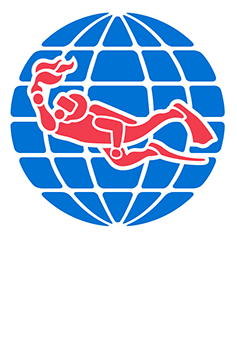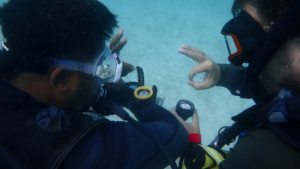
Have you ever dreamed of exploring the magical underwater world but thought scuba diving was only for athletes or marine experts? Think again! Scuba diving is more within reach than you might imagine, opening up a breathtaking realm of adventure to people from all walks of life.
Scuba diving is often perceived as an extreme sport reserved for the young, fit, and fearless. However, the reality couldn't be more different. With modern training techniques, advanced equipment, and supportive dive centers like Scuba Junkie, diving has become an inclusive activity that welcomes enthusiasts of various ages, fitness levels, and backgrounds.
The beauty of scuba diving lies in its adaptability. Professional dive centers have developed comprehensive programs designed to make underwater exploration possible for almost everyone. The Discover Scuba Diving program, in particular, has been a game-changer in introducing newcomers to the underwater world.
Contrary to popular belief, scuba diving isn't limited to professional athletes or young adventurers. Here's a breakdown of who can typically enjoy this incredible experience:
While scuba diving is possible for many, there are some conditions and situations where diving might not be advised:
It's crucial to consult with a dive medical professional and be honest about your health history before pursuing diving.
Scuba Junkie dive resorts have been at the forefront of making diving accessible to everyone. Their approach combines:
This introductory program is perfect for curious first-timers. It typically includes:
For those who fall in love with diving during their initial experience, the Open Water certification is the next step. This internationally recognized qualification allows you to:
The certification process usually takes 3 days and involves:
Many potential divers hesitate due to common fears. Here's how the diving community addresses these concerns:
Beyond the adventure, accessible scuba diving offers remarkable benefits:
Scuba diving is more than just a sport—it's a transformative experience that opens up a whole new world of exploration. With the right approach, training, and mindset, diving can be an incredible journey for almost anyone.
Remember, every expert diver was once a beginner. Your underwater adventure is just a course away!
Pro Tip: Always consult with professional dive instructors, get a medical check-up, and be honest about your physical capabilities before starting your diving journey.
Picture yourself hovering weightlessly in the crystal-clear waters of Sipadan Island, when suddenly, an incredible sight emerges from the blue – a school of massive bumphead parrotfish, their powerful bodies gracefully gliding through the water. Here at Sipadan, these magnificent creatures aren't just rare visitors; they're part of our everyday underwater family, making our corner of Borneo one of the best places in the world to witness bumphead parrotfish conservation in action.
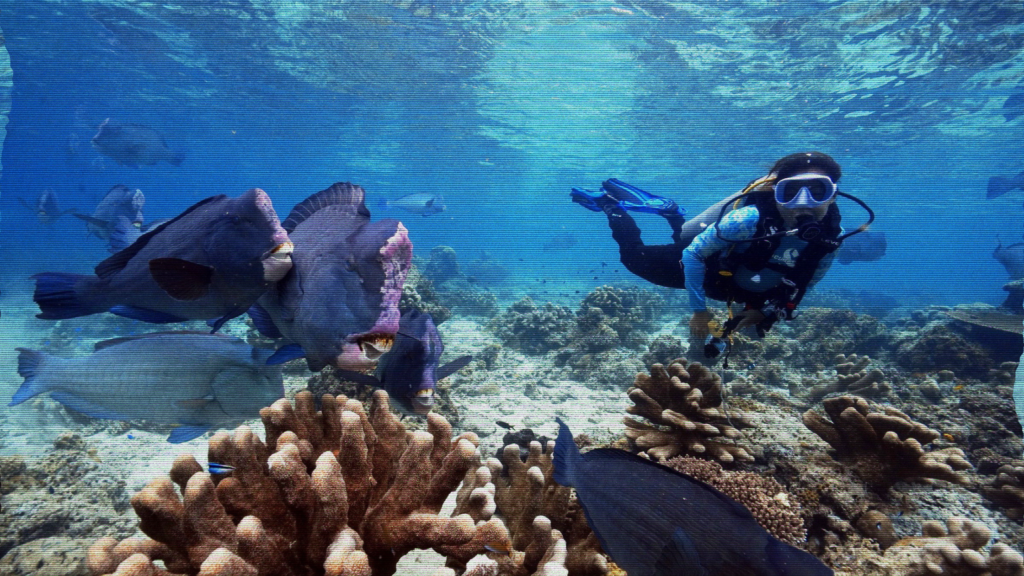
"It was like watching a herd of underwater buffalo!" That's how Sarah, one of our recent divers, described her first encounter with a school of bumphead parrotfish at Sipadan's famous Drop-Off. These gentle giants, some as big as a grown person, are regular residents at our dive sites, often gathering in schools of 20 to 50 individuals. They're so common here that our diving guides have even given names to some of the regular visitors!
Dawn at Sipadan brings a special show that few places on Earth can match. As the first rays of sunlight pierce the water, our resident bumphead parrotfish begin their daily routine. Their distinctive bump-shaped foreheads emerge from their sleeping spots in the reef, and they set off on their important mission – keeping our coral reefs healthy.
These charismatic fish transform from peaceful sleepers to busy workers as they:
According to Marine Protected Areas research, Sipadan's protected status has created a safe haven for these incredible creatures. Our location in the Coral Triangle, combined with strict conservation measures, has helped maintain one of the healthiest populations of bumphead parrotfish in the world.
Our daily diving operations at Scuba Junkie Sipadan have given us a front-row seat to one of nature's most successful conservation stories. Where many regions have seen declining numbers, our bumphead parrotfish population continues to thrive, making every dive an opportunity to witness these magnificent creatures in their natural habitat.
Want to meet these gentle giants yourself? At Scuba Junkie Sipadan, we offer daily dive trips to Sipadan Island, where encounters with bumphead parrotfish are more common than uncommon! Our experienced guides know exactly where to find these magnificent creatures and can help you:
Book your dive adventure with us and experience:
We'd love to hear about your experiences with these magnificent creatures! Have you ever encountered a bumphead parrotfish? What impressed you most about them? Share your stories in the comments below or tag us in your Sipadan diving photos on social media using #ScubaJunkieSipadan #BumpheadParrotfish.
Ready to meet our resident bumphead parrotfish? Contact us to plan your Sipadan diving adventure, or check out our special packages for the upcoming season.
Want to learn more about marine conservation at Sipadan? Visit our Conservation Projects page or follow us on Instagram and Facebook for daily updates from our underwater world.
[Editor's Note: This article was last updated on October 28, 2024, with the latest information about our Sipadan bumphead parrotfish population.]
Have you encountered these magnificent creatures during your dives? We'd love to hear your story! Drop a comment below and share your most memorable bumphead parrotfish moment with our diving community.
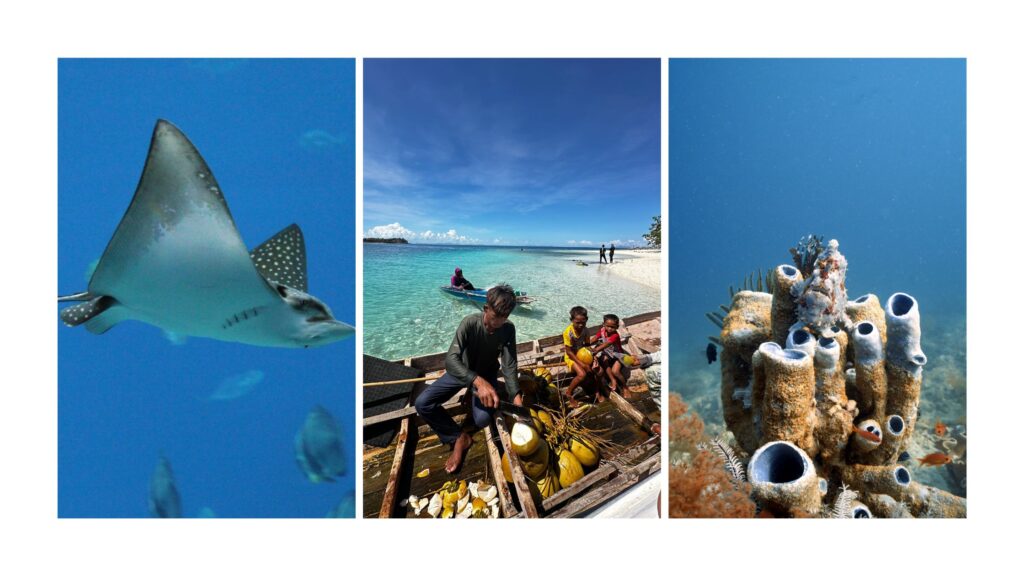
Nestled in the Celebes Sea off the east coast of Sabah, Malaysian Borneo, Sipadan Island stands as a testament to nature's extraordinary beauty. This small oceanic island, barely 12 hectares in size, has captivated the hearts of divers and marine enthusiasts worldwide. Sipadan Island closure for a month each November has become an annual event, aimed at preserving its unique ecosystem. But before we delve into the reasons behind this closure, let's explore what makes Sipadan so special.
The legendary Jacques Cousteau, a pioneer in marine exploration, stumbled upon Sipadan in 1988. Awestruck by its pristine beauty, he famously declared, "I have seen other places like Sipadan, 45 years ago, but now no more. Now we have found an untouched piece of art." This endorsement from one of the most respected names in oceanography catapulted Sipadan into the spotlight, making it a must-visit destination for divers around the globe.
What sets Sipadan apart is its distinctive underwater landscape. The island is actually the tip of an extinct volcanic cone that rises dramatically from the ocean floor. This unique topography creates a mesmerizing underwater environment, with sheer drop-offs plunging to depths of over 600 meters. These walls are adorned with vibrant coral gardens, providing a perfect habitat for an incredible diversity of marine life.
Sipadan's isolation and protection have allowed it to maintain an incredibly rich and diverse ecosystem. The island is renowned for its high concentration of sea turtles, with both green and hawksbill turtles frequently spotted. Large schools of barracuda and jackfish create swirling tornados of silver in the blue waters, while hammerhead and whale sharks make occasional appearances in the deeper waters.
The reef systems surrounding Sipadan are home to over 3,000 species of fish and hundreds of coral species. Divers can expect to encounter an array of exotic creatures, from the delicate mandarin fish to the peculiar ghost pipefish. The island's waters also host a significant population of bumphead parrotfish, which play a crucial role in maintaining the health of the coral reefs.
As one of the world's premier diving destinations, Sipadan is subject to strict regulations to ensure its preservation. These measures are crucial in maintaining the delicate balance of this underwater paradise.
Since 2009, Sipadan has been designated as a protected marine park, under the supervision of Sabah Parks. This status has been instrumental in safeguarding the island's ecosystem from the potential negative impacts of over-tourism and unsustainable practices.
To prevent overcrowding and minimize environmental impact, Sabah Parks has implemented a permit system that allows only 200 divers per day to visit Sipadan. Each permit grants a diver access to the island for one day, with a maximum of two dives allowed during that visit. This limitation ensures that the marine environment is not overwhelmed by constant human presence.
For those lucky enough to secure a permit, there are additional requirements to be aware of:
These regulations might seem strict, but they play a crucial role in preserving Sipadan's unique ecosystem for future generations to enjoy.
Every November, Sipadan Island closes its waters to divers and visitors. This annual closure is a critical conservation measure that has far-reaching benefits for the island's marine ecosystem.
The primary goal of this Sipadan Island closure for month-long hiatus is to support the health and recovery of the island's ecosystem and marine life. By reducing human disturbances, particularly those caused by scuba divers, the closure provides a much-needed respite for the underwater inhabitants of Sipadan.
During this period, the marine life can go about their daily activities without the presence of divers. This break allows for undisturbed breeding, feeding, and natural behaviors that are essential for maintaining a healthy ecosystem. Moreover, the absence of divers gives the coral reefs a chance to recover from any inadvertent damage caused by fins, hands, or equipment throughout the year.
The effectiveness of this Sipadan island closure was particularly evident in 2021 when Sabah Parks reported on the impacts of an extended 18-month closure due to the global pandemic. The results were astounding: significant coral growth was observed, and rarely found fish species were spotted in the area. This extended period of minimal human interference demonstrated the resilience of nature when given the chance to recover.
The annual November closure, while shorter, aims to provide similar benefits on a regular basis. It's a testament to the commitment of local authorities and the diving community to preserve this underwater wonder for future generations.
One of the remarkable aspects of Sipadan is its consistency throughout the year. Unlike many dive destinations that have distinct seasons for marine life or weather conditions, Sipadan offers relatively stable conditions year-round.
The marine life in Sipadan is largely resident, meaning that the spectacular biodiversity divers come to see can be observed throughout the year. From the majestic sea turtles to the swirling schools of barracuda, these creatures call Sipadan home year-round.
While Sipadan is a year-round destination, some months offer slightly more favorable conditions. The best months to visit are typically from February to June and from September to December. During these periods, the sea conditions are generally calmer, offering better visibility and more comfortable diving experiences.
January, July, and August can be a bit more challenging due to increased wind, which can make the boat journey from Mabul to Sipadan more adventurous. However, it's worth noting that even during these months, dive trips are rarely cancelled. The persistent winds might stir up the surface waters, but the underwater visibility often remains excellent, especially at depth.
While the Sipadan island closure in November might initially disappoint some divers, it presents an excellent opportunity to explore other nearby dive sites that are often overshadowed by Sipadan's fame. One such gem is Si Amil Island.
In response to the Sipadan island closure, Scuba Junkie, have begun exploring Si Amil Island. This lesser-known destination has proven to be a fantastic alternative, offering its own unique underwater experiences.
Si Amil is known for its population of devil rays and eagle rays, providing exciting encounters for divers. Additionally, the island boasts an impressive array of macro life, making it a paradise for underwater photographers who enjoy capturing the smaller, often overlooked creatures of the sea.
Picture this: The sun peeks over the horizon as you board the boat at Mabul, the salty breeze tousling your hair. As you cruise towards Si Amil, anticipation builds, your mind racing with thoughts of the underwater wonders awaiting you.
Upon reaching Si Amil, you waste no time slipping into the crystal-clear waters. The first dive is a feast for the senses - vibrant corals, curious fish darting about, and if you're lucky, the graceful glide of a passing ray. Surfacing with a grin, you swap stories with fellow divers over a hearty second breakfast, the taste of adventure still fresh on your lips.
Before you know it, you're back in the water for round two. This time, you focus on the little things - a tiny nudibranch here, a camouflaged frogfish there. The underwater world seems to unveil new secrets with each passing minute.
Lunchtime brings a welcome respite on the island's pristine beach. As you dig into your meal, keep an eye out for the local residents - not other divers, but the cheeky monkeys that call Si Amil home. Their playful antics provide the perfect surface interval entertainment.
As the day winds down, you gear up for one last plunge. The afternoon sun casts ethereal rays through the water, illuminating schools of fish and coral gardens. It's a fitting finale to an unforgettable day of diving.
With three incredible dives under your belt and a head full of memories, you board the boat back to Mabul. As Si Amil fades into the distance, you can't help but feel a sense of wonder at the hidden gem you've just explored.
What sets Si Amil apart is not just its underwater attractions but also its pristine beaches. Unlike the more developed Mabul, Si Amil offers a true tropical island experience with its turquoise waters and white sand beaches. The presence of playful monkeys adds an extra element of excitement to the surface intervals.
For those looking for even more variety, daily trips to Mabul and Kapalai continue to operate during Sipadan's closure. These sites offer their own unique diving experiences, from vibrant artificial reefs to muck diving paradises teeming with bizarre and beautiful critters.
As we wrap up our dive into the annual Sipadan Island closure, let's surface with some thought-provoking questions. Grab a virtual cup of coffee and let's chat about the future of this underwater paradise.
First off, what's your take on closing the island for a month each year? On one hand, it's a bold move towards sustainable tourism, giving the marine life a much-needed breather from our bubble-blowing presence. But on the flip side, it's not a simple decision. There's a delicate balance between preserving nature and supporting the local economy that relies on dive tourism. Do you think this annual timeout strikes the right balance, or should we be exploring other approaches?
Speaking of approaches, let's dream big for a moment. If you were in charge of Sabah Parks for a day, what would be on your conservation wishlist? Maybe you'd push for stricter enforcement of diving regulations? Or perhaps you'd love to see more extensive research programs to really understand what's happening beneath the waves? How about ramping up education initiatives for both locals and tourists? The possibilities are as vast as the ocean itself. What ideas do you have that could take Sipadan's protection to the next level?
Now, here's a question that really makes you dive deep: Does this month-long closure actually make a splash in terms of conservation? We saw some pretty amazing results during the extended closure in 2021, with coral growth and rare fish sightings. But when it comes to the annual one-month break, the effects might be more subtle. How do you think we could measure the impact? Are there creative ways we could quantify the benefits to really understand if this approach is working?
These aren't just rhetorical questions – we really want to hear your thoughts! As fellow ocean enthusiasts, your insights and ideas could spark the next great conservation initiative. So don't be shy – dive into the comments and let's keep this important conversation flowing. After all, it's going to take all of us working together to ensure that future generations can experience the magic of Sipadan just as we do today.
Remember, every comment, every idea, and every action, no matter how small, can create ripples of change. So, what are your thoughts on preserving paradise?
As I reflect on the past 20 years as a PADI Course Director, I am filled with an overwhelming sense of gratitude. From the first moment I stood in front of my very first PADI IDC Class in August 2004, I cherished the opportunities to guide hundreds of aspiring PADI Instructor candidates through the intricacies of becoming Dive Leaders. This journey has been nothing short of extraordinary.
The most rewarding aspect of my career is seeing my former Instructor Candidates becoming colleagues, striving and making positive impacts in the Dive Industry. As a PADI Course Director & Instructor Trainer, I’ve had the honour of mentoring many fantastic individuals, helping them transform their passion for diving into a professional pursuit. Watching my candidates grow into confident and competent instructors, capable of inspiring the next generation of divers, has been immensely fulfilling.


As we look ahead to 2025, we are excited to announce three PADI Instructor Development Courses (IDC) will be scheduled at Scuba Junkie's Mabul Beach Resort for February, May and November. A multi-Awarded Resort and Dive Center, Scuba Junkie is one of Southeast Asia premier PADI 5 Star Facilities, and the PADI IDC Program will continue with me, a 20 years experienced and multi-Awarded PADI Course Director (Thien X. Do, CD-469459).
The dive center at Mabul Beach Resort is designed by divers for divers. Our 2025 PADI IDC curriculum is equipping the next generation of PADI instructors with more real life skills, knowledge and adaptable teaching techniques to accommodate divers from all cultures to succeed in learning to scuba dive. The programs will be more comprehensive and efficient than ever, incorporating the latest advancements in diving education and instructional techniques to ensure all candidates are competent and confident to conduct their first PADI courses successfully.
Why Choose Our PADI IDC and Instructor Training Program?
Choosing the right instructor training program is a crucial and impactful decision for any aspiring scuba professional. It sets the foundation for your career and influences your future success in the diving industry.
Here’s why our program stands out:
Experienced PADI Course Director & supporting Pro Team of Instructors: With 20 years of instructor training experience, candidates will gain a wealth of knowledge and expertise from us. Our supporting team of PADI Staff Instructors also includes some of the most experienced and respected professionals in the industry.
Eco Friendly 5 Star Facilities: Scuba Junkie Dive Centre is among the best in Malaysia, with spacious seminar room for class presentations, FREE wifi access, hundreds of cylinders, dive equipment and "the cleanest" air & nitrox filling station in Asia. This ensures that our instructor candidates have access to the best resources available.
Regional Network: Did you know that Scuba Junkie has 5 dive centres and a Five-Star Liveaboard yacht in Southeast Asia? This network provides our PADI IDC candidates with valuable opportunities for employment, career advancement, collaboration, and continued learning.
Proven Track Record: Our program has a proven track record of success. Most of our graduates have gone on to successful careers as scuba instructors, dive centre managers, and marine conservationists.
Why wait? Reach out to Scuba Junkie now for more details on the upcoming Instructor Development Courses!
Post written by Thien X. Do PADI Course Director
As scuba divers, we all know the feeling of descending into the underwater world and realizing that verbal communication is no longer possible. The good news is that hand signals allow divers to communicate efficiently during dives. Mastering them is one of the first skills student divers learn. Knowing these gestures thoroughly before submerging is crucial for safe and enjoyable dives.
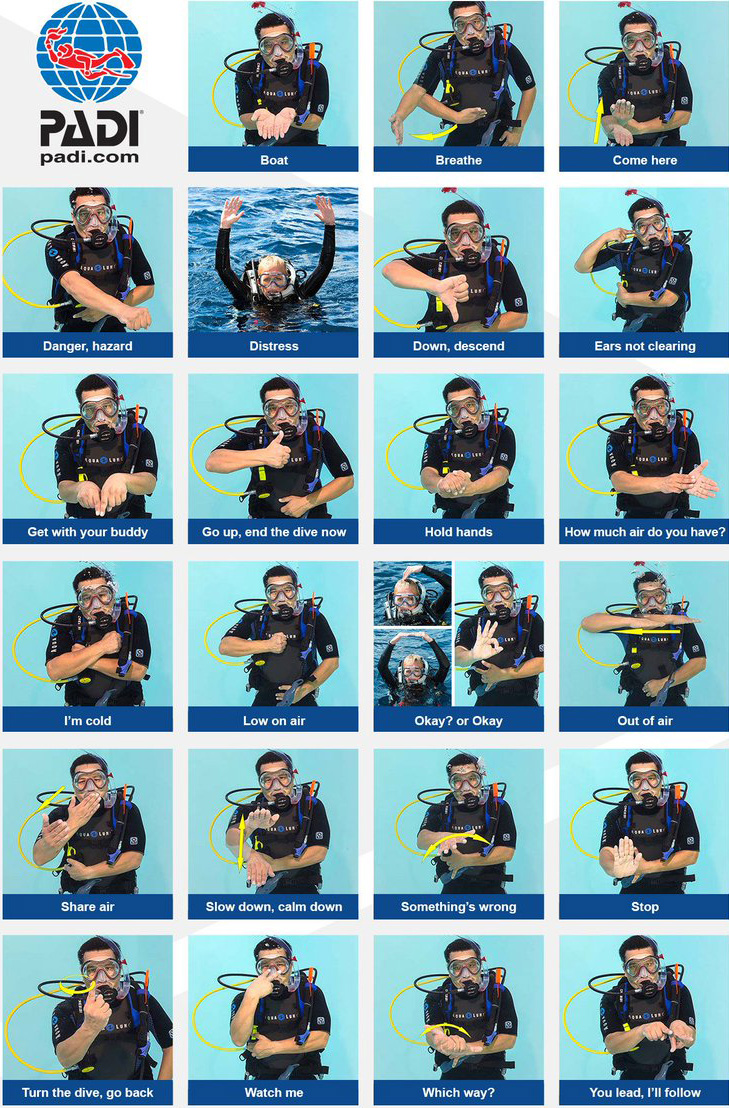
Hand signals are an essential skill that every diver must master before entering the water. They allow you to convey messages to your buddy when voice communication isn't possible, transcending language barriers and allowing divers from all over the world to understand each other. Learning them thoroughly ahead of time prevents confusion and dangerous situations underwater when you need to communicate quickly and effectively. Mastering them ensures you and your buddy have a shared understanding, even if you've never dived together before.
When executing hand signals underwater, keep these do's and don'ts in mind:
Becoming an expert in scuba hand signals doesn't happen overnight - it takes time and dedication to commit these gestures to memory. But practicing can be fun! Grab your buddy on dry land and quiz each other on key signs. Repetition helps build the muscle memory you need to flash signs smoothly once you're 20 meters underwater. Make a game out of testing yourselves so you're ready to chat easily during your dives. Before you know it, you'll be a pro!
Once you've memorized basic recreational scuba hand signals, it's time to put your skills into practice! Enroll in a PADI Open Water diver certification course from a trusted dive operator. Instructors will thoroughly review hand signals and even teach you new specialty gestures. With quality training from skilled professionals, you'll be mastering hand signals and exploring the underwater world in no time.
Want to test your hand signal skills? Reply to this article and mimic the following signals using emoji:
How did you do? Practicing hand signals like this ensures you'll be prepared to communicate underwater. Safe and fun dives ahead!

A dive computer is an electronic device used by scuba divers to monitor depth, time underwater, and decompression requirements during a dive. It provides real-time data to help divers make safe decisions and avoid decompression sickness. Dive computers contain an electronic algorithm that tracks nitrogen levels and calculates no-decompression limits.
While not absolutely required, having a dive computer is highly recommended for most divers. Dive computers provide an added level of safety and convenience compared to relying solely on dive tables or gauges. They monitor data in real time, accounting for actual dive conditions, and reduce the risk of human error in calculations. For recreational diving, a basic dive computer can suffice. Technical diving may require more advanced dive computer features.
The main features you need in a dive computer include depth and bottom time. With these, your computer can calculate your no decompression limit - the maximum time you can safely stay underwater without needing decompression stops. Some other helpful features to look for are safety stop guidance, ascent rate monitoring, surface time tracking, and dive planning modes. Although recreational divers should not intentionally go into decompression, having a computer that can show decompression stops is useful in case you accidentally exceed no-decompression limits.
Additional useful features to consider are dive modes for air, nitrox, and free diving. For more advanced tech divers, the ability to monitor multiple diving gases is an important feature. When shopping for a new dive computer, think about which features match your experience level and diving needs. The right computer will have the essential functions for safety and convenience, but you may also want to consider extras that suit your goals as you progress as a diver.
The number of buttons is something beginner divers may not consider, but it can greatly impact how easily you navigate the computer's menu.
Computers with only one button can be tricky to use. You have to click the button repeatedly to scroll through all the options, and if you miss what you need, you have to start over again.
Dive computers with multiple buttons allow for easier navigation like being able to go back, forward, up and down through the menus. This prevents getting lost or having to restart your search for a particular function.
Before deciding which dive computer to buy, try playing around with the menu structure if possible. Make sure it feels intuitive and easy to find the information you need. The layout of the buttons and menus can vary greatly between models. Choosing a computer that allows you to quickly access key data with minimal buttons pushes will lead to a much more enjoyable and stress-free diving experience. Taking the time to test different interfaces can help you find a user-friendly option that best fits your needs as a diver.
Battery life is limited, whether you choose a rechargeable or disposable battery.
With disposable batteries, you'll likely need to replace them every 1-2 years. While you can replace batteries yourself, it's best to take the computer to a dive shop. They can properly replace the battery and O-ring, often using a battery kit. The risk is running out of battery during a dive, although most computers display low battery warnings. Once replaced, the computer functions like new again.
Rechargeable batteries ensure a full charge for every dive when maintained properly. You avoid buying replacement batteries yearly. However, as with phones and devices, after the battery's lifespan (usually under 5 years), runtime per charge decreases. Eventually you'll need to purchase a new dive computer.
Both battery types have trade-offs. Disposable batteries need regular replacement. Rechargeable batteries lose efficiency over time. Consider your diving frequency, cost factors, and willingness to replace the entire computer when choosing between battery types. Testing battery life and watching for warnings is key for reliability, regardless of battery type chosen.
Perhaps the biggest advantage of a wrist mounted dive computer, specially the watch size models, is that you can wear it wherever you go. It’s easier to pack for travel and allows you to use your own computer when you rent gear. Wrist mounted dive computers are often a more stylish option than console computers, and can come with air integration and a compass.
They usually have larger, more readable screens and buttons that are easier to push. Since they attach to your regulator, you won't risk forgetting your computer behind. With everything displayed on one unit - depth, times, heading, gas data - consoles allow checking key info at a glance.
Consider your needs and preferences when choosing between these common dive computer styles. Wrist computers provide versatility and style. But consoles integrate more data in an easy-to-view layout. Think about convenience, ease of use, and how you dive to decide which design works best for you. Trying on different styles can help determine the most comfortable and practical fit.

After considering the must-have and nice-to-have features, it's time to look at budget. Today there are lots of high-tech options like Bluetooth connectivity, heart rate monitoring, color screens, GPS tracking, and smartwatch integration. It's easy to get carried away adding features if money is no object. However, with a limited budget, focus on the essential functions you need and avoid unnecessary bells and whistles.
Ask yourself - do you really require all those extras? More money spent equates to more features, but the diving necessities are most important. Those with smaller budgets will want to weigh each added feature against the cost.
In the end, an affordable dive computer with the basics like depth, time, and decompression tracking is entirely sufficient for recreational diving safety. While it's exciting to have cutting-edge tech, the latest gadgets aren't required for an amazing diving experience. By carefully considering your personal needs and budget, you can find just the right dive computer at a price you're comfortable with.
Look out for seasonal sales and discounts when shopping for a dive computer. As new models come out, you can often find great deals on remaining stock of older models. Watch for sales around the holidays like Black Friday for potential savings.
Consider buying used from a trusted source. Sites like eBay or scuba swap shops can connect you with lightly-used computers from other divers upgrading their gear. Ensure the computer is in good condition and has been recently serviced before purchasing used.
Rent before you buy. Many dive shops offer computer rentals for a small fee. Renting first can help you try out different makes and models to see which interface and features you like best before investing in your own.
Start with an entry-level computer, then upgrade later as your needs evolve. As a new diver, an advanced tech computer may be overkill. Begin with an affordable model with the essentials, then you can upgrade to more advanced dive computers as you progress.
By taking advantage of sales cycles, buying used, renting, and starting simple, you can find a quality dive computer that fits both your diving needs and budget. The right gear is out there with a savvy purchasing approach.
Choosing the right dive computer involves considering your experience level, diving environment, must-have features, and budget. By outlining your needs, you can narrow down the choices and find a computer that fits your diving lifestyle. Try on different styles and test interfaces when possible. Read reviews from other divers using the models you are considering. Invest in a computer appropriate for where you are now as a diver, but also one that will grow with you as you progress.
Once purchased, be sure to fully read the manual to understand your computer’s capabilities and how to operate it safely. Perform pre-dive safety checks on battery life, oxygen sensors, etc. With proper care and maintenance, your new dive computer will become a trusted underwater companion for many adventures to come.
What dive computer do you use and recommend? Share your thoughts and experience in the comments below!
If you thought you've seen amazing things during your day dives, wait until the lights of the torches take you to the unreal experience of the Night Dives in Mabul.
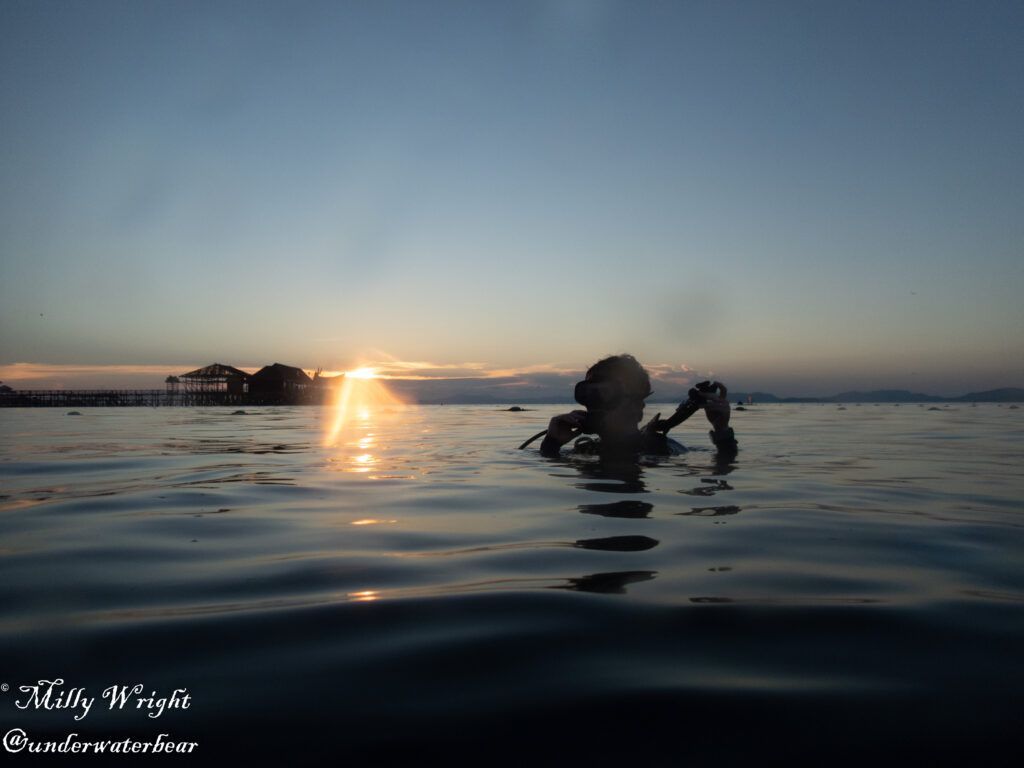
When the lights of the sun start fading. When the sounds and movements of the day slowly give way to the peace and silence of the dark. When the boats turn off their engines and rest until the new dawn. At this exact moment, something changes underwater. Sand and sea grass might not sound so appealing to you but it's home to the most particular and unique critters (Muck diving).
And at Scuba Junkie, we have it right out of our jetty. Let your imagination run wild, while I tell you the story of, so far, my best Night Dive.
It was the end of a long week teaching courses, and as much as I like to teach it can also be exhausting. I'm not going to get into details, but mentally I had a lot happening, and fiscally I was tired.
I'm halfway through the day and it's now lunchtime. On my way to the restaurant, I see the torches laying on the counter of the dive center and somehow I felt them calling me.
I tend to follow my feelings, in general, that's where all my adventures begin. I knew I had to go for it, what I didn't know was that this was going to be the most wonderful Night Dive I had so far.
The sun is setting, my customers arrived, I welcome them and start the briefing. I explain the topography of our dive site Awas, and let them know my plan for the night dive; head all the way to “the nets” nonstop where a Rinhopias it's living at the moment, and then slowly make our way back. We all agreed and at the end, like usual I ask what are they expecting to see, which I regrated a few seconds later.
Their expectations were high, they wanted to see the most difficult creatures to find, some of which I'd only heard about it. I started laughing, I could not help it, and told them I was going to do my best but could not promise anything, except for the Rhinopias.
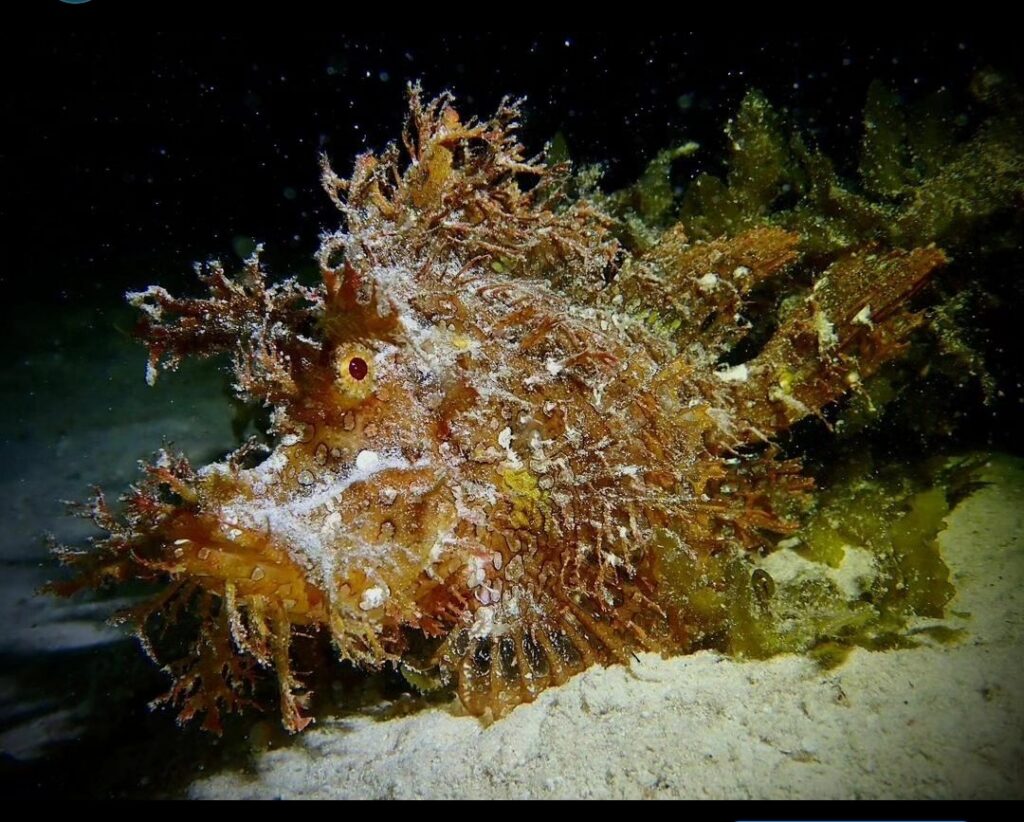
In between jokes, the sun starts hiding behind the resort, we gear up, get in the water, turn our torches on, and begin our dive. As usual in a shore dive, we started the dive against the current, which that night was a bit stronger than I expected. I follow my plan, and reached the destination.
There she was, the beautiful Rhinopias, mission accomplished. My day was already better, everything after that was a blessing.
I turn the dive and ask everyone their air pressure, all good, they're coping well with the current. Started making our way back and we found not one but two Ambons scorpionfish, that were having a bit more trouble with the strength of the water that day.
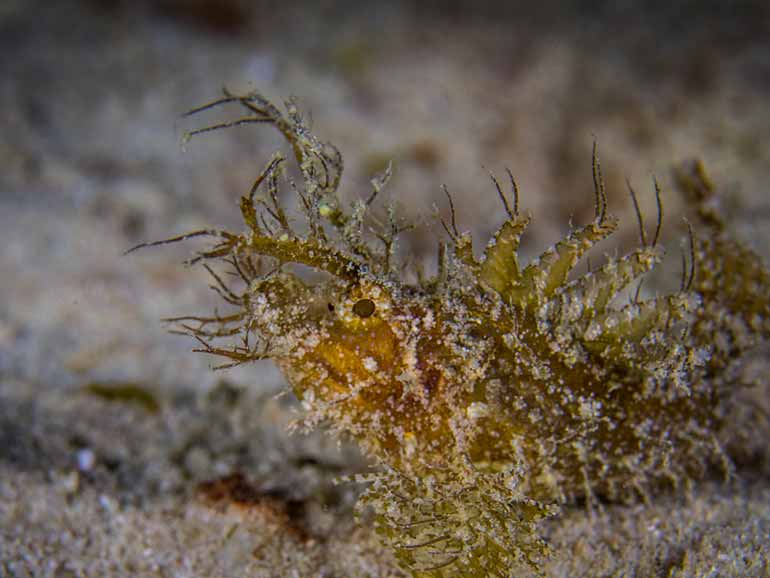
I was getting super excited! Turn around to keep going and the light flashes into a Coconut octopus, who was hanging out with his friend Mr. Wonderpus. It's this even real? Just when I thought it could not get any better, Bobtail squid, one of the cutest creatures in my opinion. And this doesn't stop here, getting closer to the jetty a painted Frogfish. Everything request was delivered, and even more. I could not believe my eyes, my luck, my night dive!
The stress, tiredness, problems, everything accumulated in one week was gone in a 60 minutes dive. Never underestimate the power of a peaceful Night Dive. Watching the beauty of the nocturnal creatures under the spotlight of the torch connects you to the moment. There's nothing else, You, your torch, the bubbles, nature, and of course your buddies. We all got out of the water with the biggest smiles, shiny eyes, with memories that will stay with us for the rest of our lives.
Open Water or Advanced, beginner or experienced diver, we will take you on this adventure with the passion that all staff in Scuba Junkie has for diving. As well as me, my colleagues also enjoy every moment underwater and the best part it's that we love to share it with our customers. We want you to leave Mabul Island not only with nice holiday memories but also with a once in the life type of experience. Give you a taste of what we're so lucky to experience almost every day.
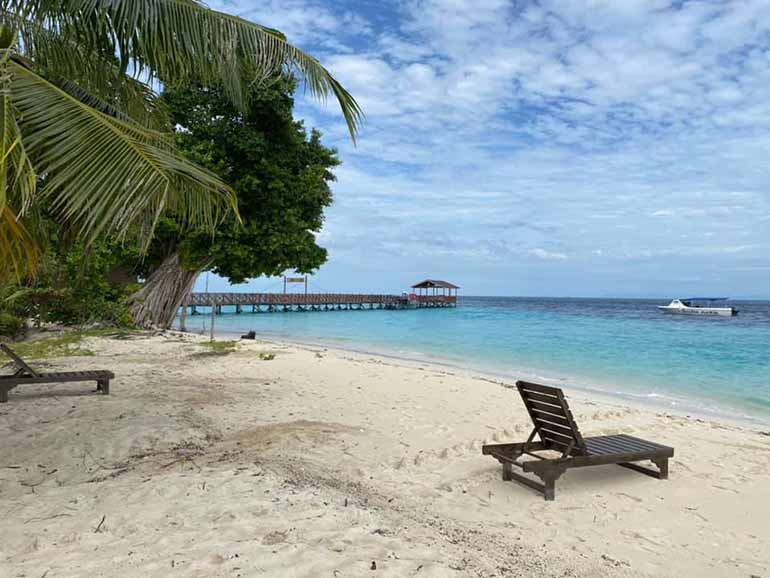
PADI Discover Scuba Diving experience. Join Cintia on her journey from beginner to Scuba Instructor.

I'm a girl from the countryside in Argentina, raised surrounded by cows and living 800km from the nearest beach, the ocean was something very scary. At the same time, I've always felt fascinated by this enormous blue magical mass of water. So when my dad suggested on a family holiday that we could go to the sea and try a Discover Scuba Diving (DSD) I didn't hesitate for one second. So many years have passed since that day but I still remember every moment.
We started very early in the morning, first things first, filling up all the paperwork. Followed by checking the equipment, BCD(buoyancy control device), wetsuit, fins, and mask. Once everything was set up we had a briefing about the basics we needed to know to go underwater. Breathing and equalization techniques, signals and communication, and the functioning of the equipment.
One by one we started gearing up and going to the swimming pool to perform some skills before the actual dive. I was very nervous, my heart was beating so fast, and my hands were shaking, but I really wanted to do this so off I go to the water. I'm floating at the surface with all the gear on, feeling scared and excited, a rollercoaster of emotions. The instructor starts deflating my BCD and little by little I started sinking.
My first breath underwater. I almost cry, not only was I excited but also so proud of me for being able to do something so challenging! There I am performing the skills needed, with total ease, to go later to the ocean. The first test passed, time for the real thing.
So out of the swimming pool and short walk to the beach, where the boat was waiting for us. Coming closer to the dream that it's kind of becoming a nightmare, the stress starts rising. The boat was not a problem but I'm more of a river person, and the ocean truly scared me.
After ten minutes we arrived to the dive spot I jumped into the water, I'm in front of my instructor, and we are starting to descend, second breath underwater? I don't think so! I panicked completely, was I going to give up? Definitely not. So I go for a second time and guess what? this time I succeeded! And it was the most wonderful experience, so amazing that I made this my profession. That day, at sixteen years old I decided that one day I was going to become a professional diver.

Ten years later, few more DSD, and many certifications my teenage dream became true, another five years have to pass to find myself working in one of the top ten diving places in the world, Sipadan, in the company that today I call home Scuba Junkie.
Today it's me who takes people for their first breath underwater and what better place to do it than at Scuba Junkie Sipadan. Here on a Discovery Scuba Dive (DSD), you can get an introduction to this wonderful blue world, you can choose to take two or even three dives and appreciate a variety of marine life that I haven't seen in my seven years of diving, just outside of our jetty (and I've been diving in all the continents). Turtles are almost guaranteed in all our dives, with no need of taking a boat and the corals are still healthy in this isolated part of the world. The water is warm and clear, perfect to make bubbles all year round.
After your first breath underwater I can promise you will get addicted to it, and the good news is, we are here to fuel your addiction.
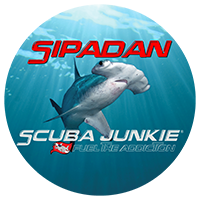
I am going to be honest. I got into wreck diving almost by accident. I have always chased beautiful coral reefs and kind of snobbed wrecks a little bit. I just thought they were a mass of iron in the sea, really.
But that was until I moved back to Italy for a couple of years, where there is an abundance of wrecks and a scarcity of corals. I had no choice other than diving those wrecks, but that gave me the time to really appreciate them: the history they carry, the sheer amount of marine life in them, and the beauty and magical atmosphere they hold.

So, when during my instructor development course and MSDT preparation (Master Scuba Diver Trainers need to be able to teach at least five specialties) I had to choose the specialties I was going to teach, it really was a no-brainer: I 100% wanted to be able to offer the Wreck Diver Course.
It is now perhaps my favourite specialty to teach because it entails a lot of planning, visualising, and challenges in terms of diving skills.
Penetrating a wreck can be a pretty steep learning curve: your buoyancy needs to be always super controlled, your knots need to be on point, mapping and navigation skills are also a crucial part of wreck exploration, as well as bringing with you a redundant air source. However, it is such a rewarding feeling to successfully complete your first penetration dive; and frankly, you look pretty badass doing it too.
And not only that, by boosting your diving skills you will feel more confident for the next diving adventures that lie ahead of you.

Here on Mabul we have a lovely wreck, which is perfect for the Wreck Diver Specialty! It is called Paradise and it is a series of sunken boats of different sizes: four smaller speed boats and one bigger decommissioned police vessel.
If you are wondering what the course consists of, let me explain it to you!
After completing the theory, there are four training dives. In the first one, you will learn how to navigate to and from a wreck, and identify points of interests as well as potential hazards. From the navigation, we will move into the mapping portion of the course during the second dive. You will effectively map the wreck and locate possible entry and exit points. The third dive will focus on practicing laying the penetration line outside the wreck (and before that we’ll have some dry runs too!), whilst in the fourth and final dive you will actually lead the penetration of the wreck: you’ll plan, navigate, bring a redundant air source, lay the penetration line and lead the penetration itself.
They say you will never forget your first underwater breath… but I can assure you, you will not forget your first wreck penetration either!

Are you looking to become a certified scuba diver and explore the incredible underwater world? If so, the PADI Open Water Course is the perfect place to start. And there's no better place to take it than in Malaysia!
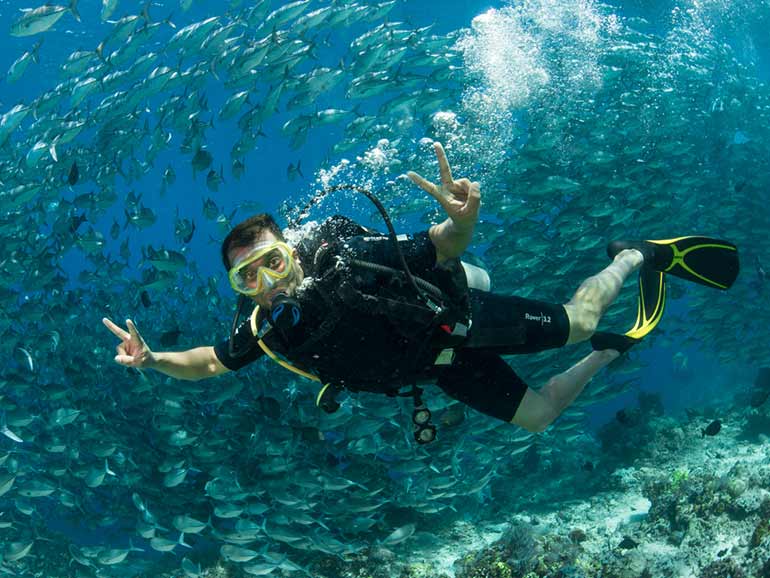
It's the first step to becoming a certified diver: The PADI Open Water Course is the entry-level certification for scuba diving, and is recognized worldwide. It will teach you the basic skills and knowledge you need to safely dive to a maximum depth of 18 meters (60 feet) under the supervision of a dive professional.
It's a fun and exciting adventure: Scuba diving is a thrilling activity that allows you to explore the underwater world and see marine life up close. The PADI Open Water Course will give you the skills and confidence you need to dive safely and enjoy this amazing adventure.
It's a great way to meet new people: The PADI Open Water Course is a social activity that allows you to meet new people and make friends with similar interests. You'll be diving and learning with a small group of people, and many people make lasting friendships through scuba diving.
It's good for your health: Scuba diving has been shown to have numerous health benefits, including reducing stress, improving mental clarity, and increasing cardiovascular fitness. The PADI Open Water Course will teach you how to dive safely, so you can enjoy these benefits while minimizing any risks.
It opens up a world of travel opportunities: Once you have your PADI Open Water certification, you can dive anywhere in the world where it's safe to do so. This opens up a whole world of travel opportunities, and allows you to experience the underwater world in a whole new way.
Overall, the PADI Open Water Course is a great way to learn how to scuba dive safely and have fun doing it. Whether you're looking for a new hobby, an exciting adventure, or a way to meet new people and travel the world, scuba diving is a great choice.

With its crystal clear waters, colorful coral reefs, and diverse marine life, Malaysia is a premier destination for scuba diving. And with its affordable prices and accessible dive centers, it's the perfect place for both beginners and experienced divers to learn and explore.
Malaysia is home to a wide variety of marine life, including colorful coral reefs, schools of tropical fish, and even turtles and sharks. Scuba diving is a great way to explore this amazing underwater world and see these creatures up close.
Malaysia is a popular scuba diving destination, so there are plenty of dive centers and instructors available to help you get started. Whether you're a beginner or an experienced diver, you'll find plenty of options to suit your needs.
Malaysia is generally a very affordable country, and scuba diving is no exception. You can find good deals on dive packages and equipment rentals, making it an accessible activity for travelers on a budget.
Malaysia has some of the most beautiful scuba diving spots in the world, including the crystal clear waters of Sipadan Island, incredible macro life in Mabul and Kapalai, and the stunning coral reefs of the Kota Kinabalu Islands. After you've seen the underwater world, you can also explore some amazing land trips, whether it be experiencing the oldest rainforest in the world, cruising the Kinabatangan river, or climbing Mt. Kinabalu - the highest peak in Borneo!
In addition to the amazing marine life, scuba diving in Malaysia also offers the opportunity to learn about and experience the local culture. There are many cultural experiences to discover, such as visits to local villages or temples, as part of their packages.
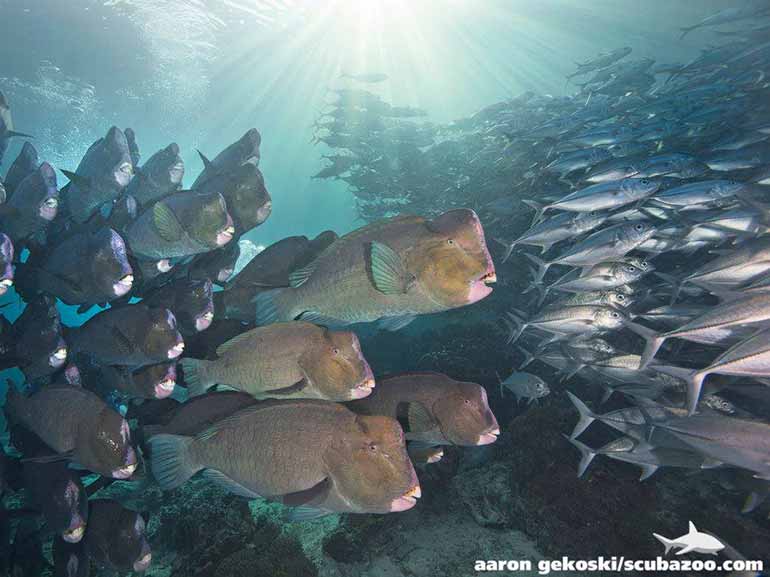
Scuba diving in Malaysia is a unique and exciting way to experience the beauty and diversity of the country. Whether you're a seasoned diver or just looking to try something new, Malaysia has something to offer for everyone.
In the PADI Open Water Course, you'll learn the basic skills and knowledge you need to dive safely to a maximum depth of 18 meters (60 feet) under the supervision of a dive professional. You'll also have the opportunity to meet new people, experience the local culture, and enjoy the numerous health benefits of scuba diving.
So why wait? Start your journey to becoming a certified diver in the beautiful waters of Malaysia. You won't be disappointed.
